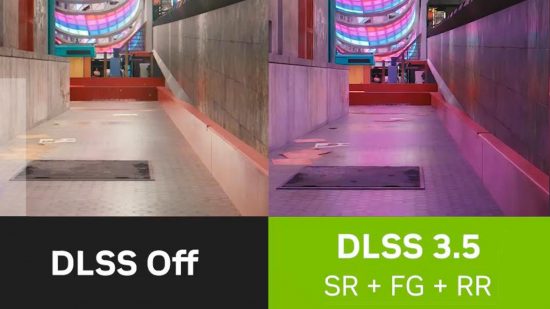Nvidia has taken the opportunity of using Gamescom 2023 to announce the latest version of its DLSS upscaling technology. DLSS 3.5 adds a new ray reconstruction element that greatly enhances the quality of ray-traced lighting effects using a new ‘supercomputer-trained AI network’.
The best demonstration of the technology that Nvidia has provided can be seen in the image below, which compares a scene with no DLSS, using DLSS 2, using DLSS 3, and using the new DLSS 3.5 ray reconstruction.
It isn’t entirely clear why the ray tracing effects are so muted in the image without DLSS, but you can clearly see the greatly enhanced effect of the ray traced global illumination lighting in the DLSS 3.5 image. There’s far greater overall diffuse purple lighting from the overhead lights with greater detail in that reflected lighting too.
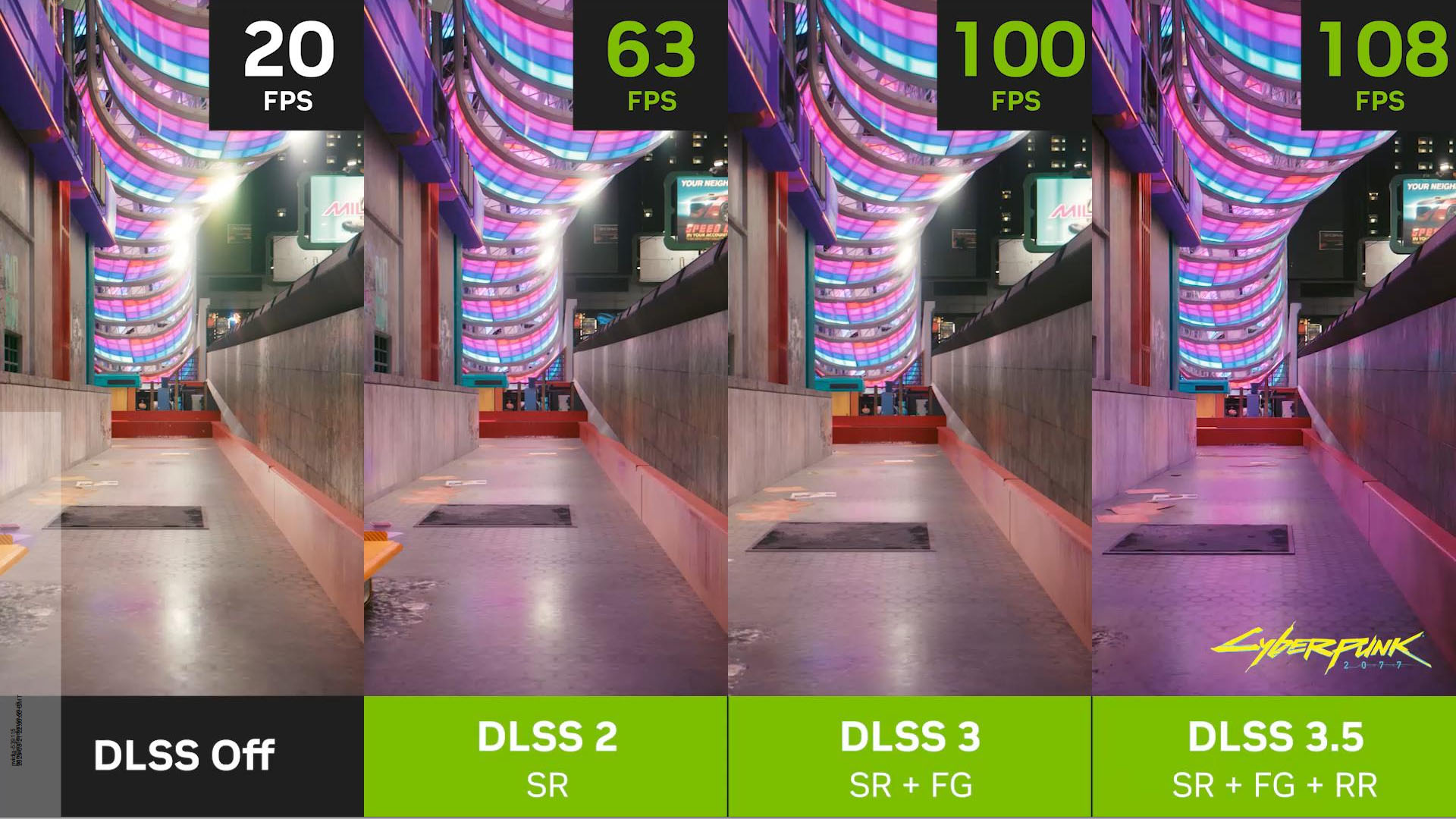
Another image (below) provided by Nvidia also very clearly shows the enhanced detail in reflections that can be achieved with DLSS 3.5. The image on the left without DLSS shows a blurry reflection that’s very indistinct, while the image on the right with DLSS 3.5 shows crisp details.
Arguably, the detail in this image actually reduces the sense of realism as you’d only get that level of crisp detail if specifically looking at the distant reflected object in the puddle (which would blur the rest of the scene) but that’s a broader issue with how 3D graphics is rendered without focus points anyway.
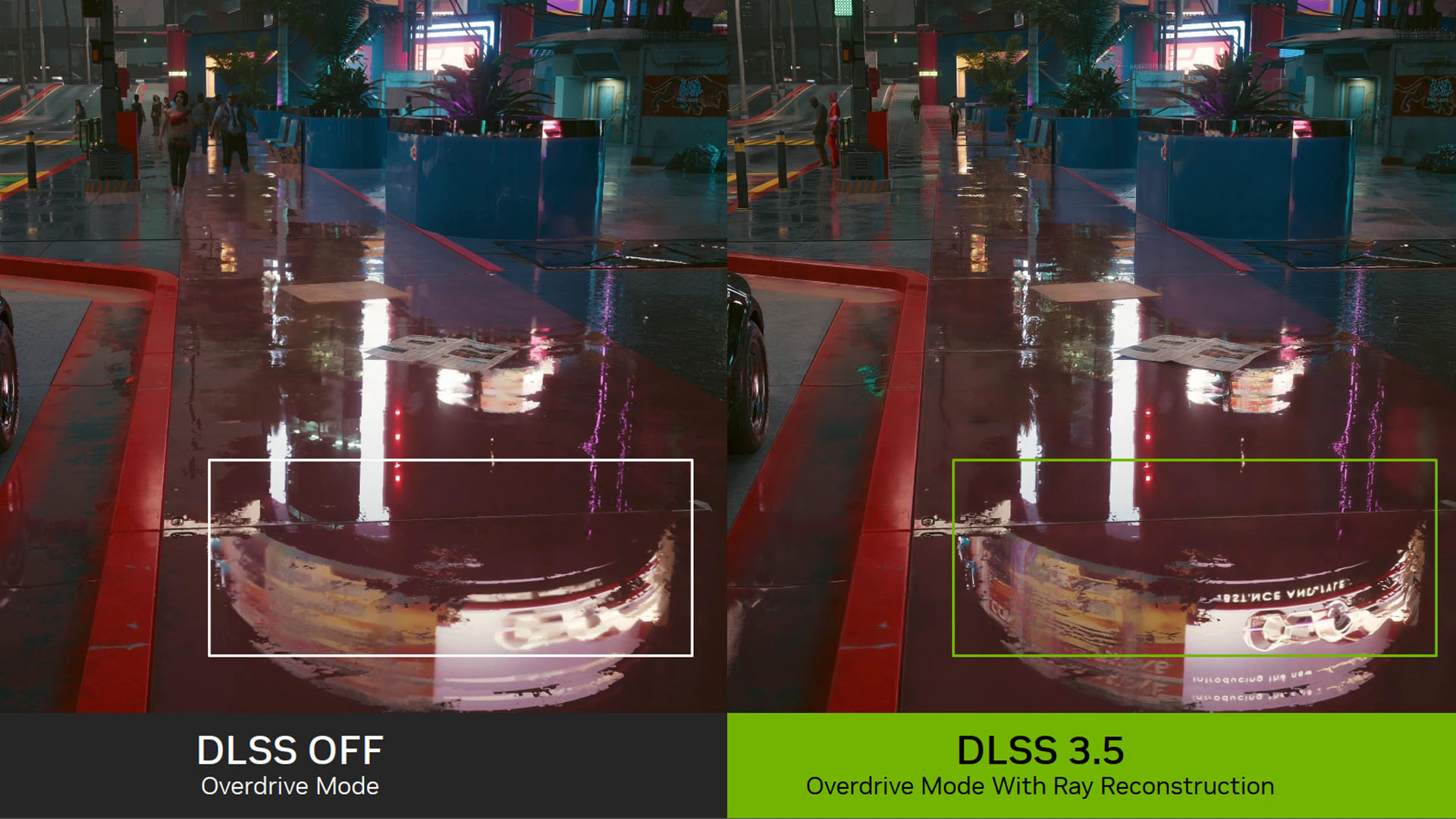
The larger unknown is just how representative these images are of more typical usage of the new technology. Are these extreme edge cases and more often than not the difference is vanishingly subtle? We’ll have to test the technology for ourselves to find that out. For those lucky enough to attend Gamescom, you’ll be able to try the new technology yourself at Nvidia’s booth.

How does DLSS 3.5 work?
Because ray tracing is so compute-intensive, when calculating ray-traced effects such as reflections and global illumination, games will only calculate the paths of a few rays and interpolate the rest of the effect from that small set of samples. If just these rays were rendered you would end up with the sort of images shown below, where there are just a few colored dots on a largely dark background.
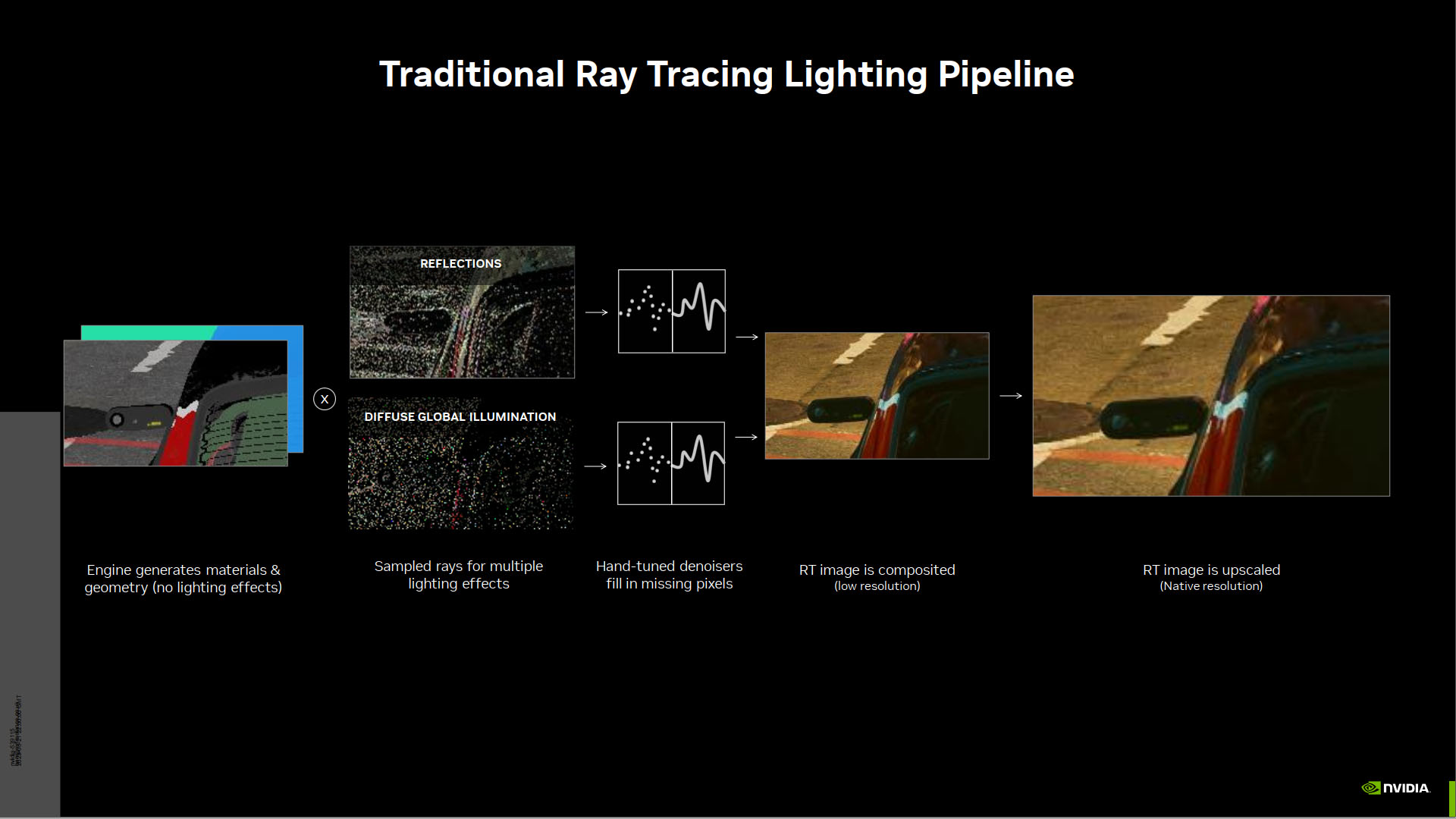
These dots are traditionally passed through various steps to interpolate and denoise the image to get a more spread-out effect for the lighting (spatial interpolation). This can include using a comparison with previous frames to help inform the best way to fill in the missing samples (called temporal accumulation).
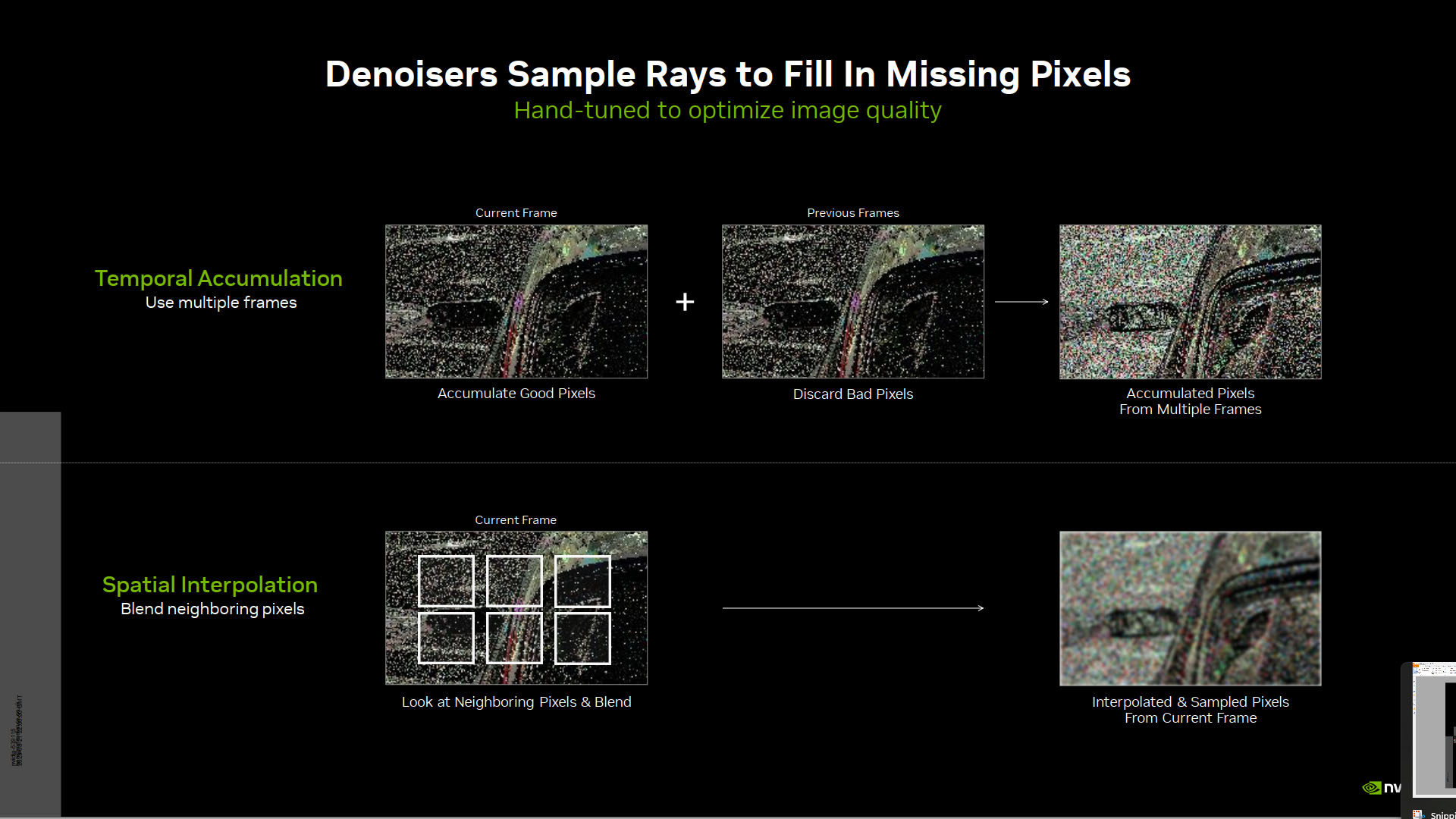
However, Nvidia points out that previous techniques can suffer from generally poor quality effects quality, with artefacts such as ghost ray-traced lighting effects (as shown in the image below – the ghostly wing mirror trails) or muddy, indistinct effects.
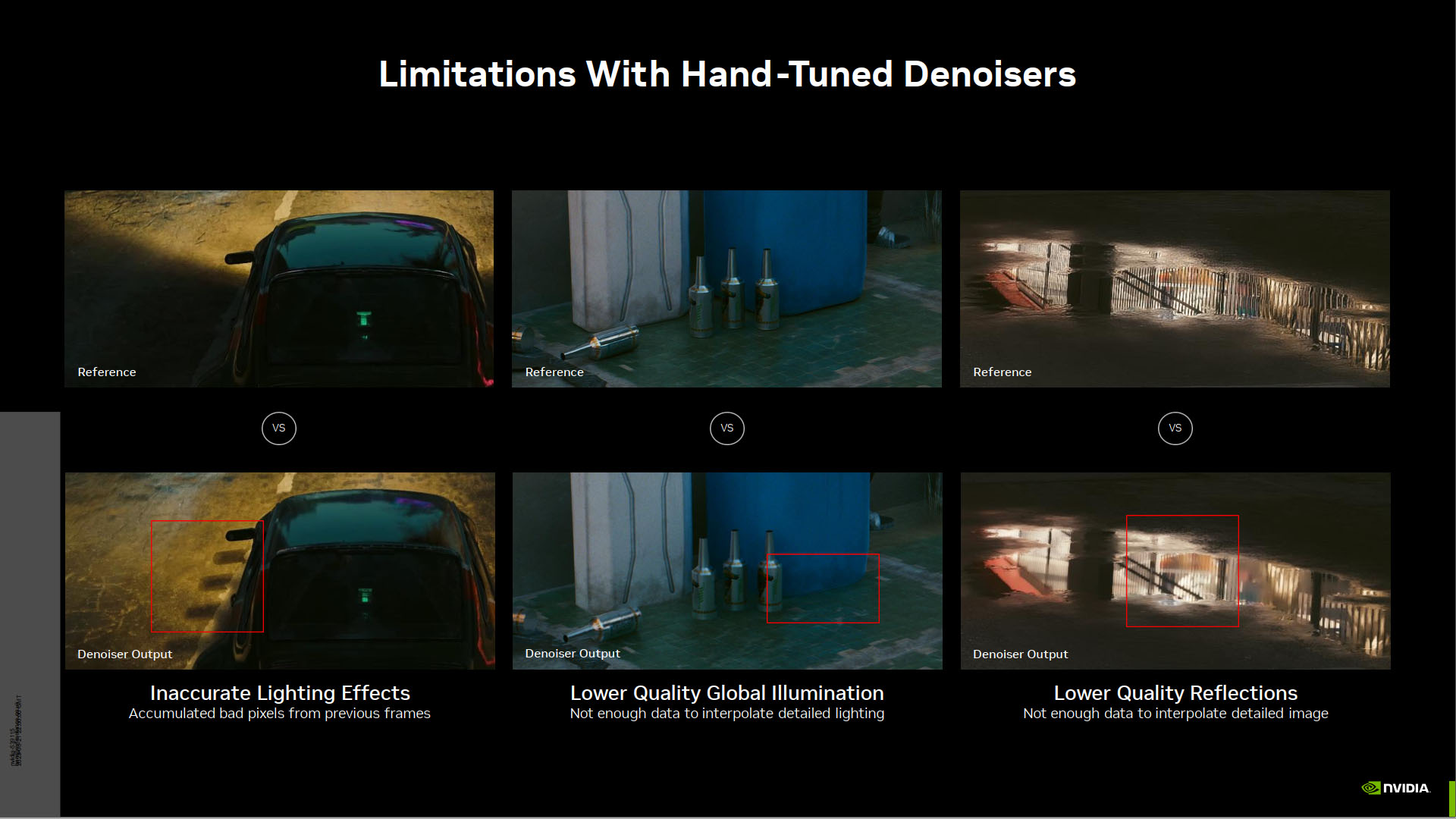
DLSS 3.5, then, adds an extra step in the process that uses ‘AI-powered ray reconstruction,’ which incorporates surface color, motion vector, and surface normal (the direction perpendicular to a surface) data and is trained to recognize different ray-traced effects, ‘good’ and ‘bad’ pixels, and high-frequency data (i.e. image detail).
It’s essentially the same ‘deep learning’ secret sauce that Nvidia introduced with DLSS 2 to inform its upscaling algorithm, but optimized for upscaling ray tracing effects. The end result is that you get far more retained detail and a reduction in temporal aliasing, such as the ghostly wing mirror.
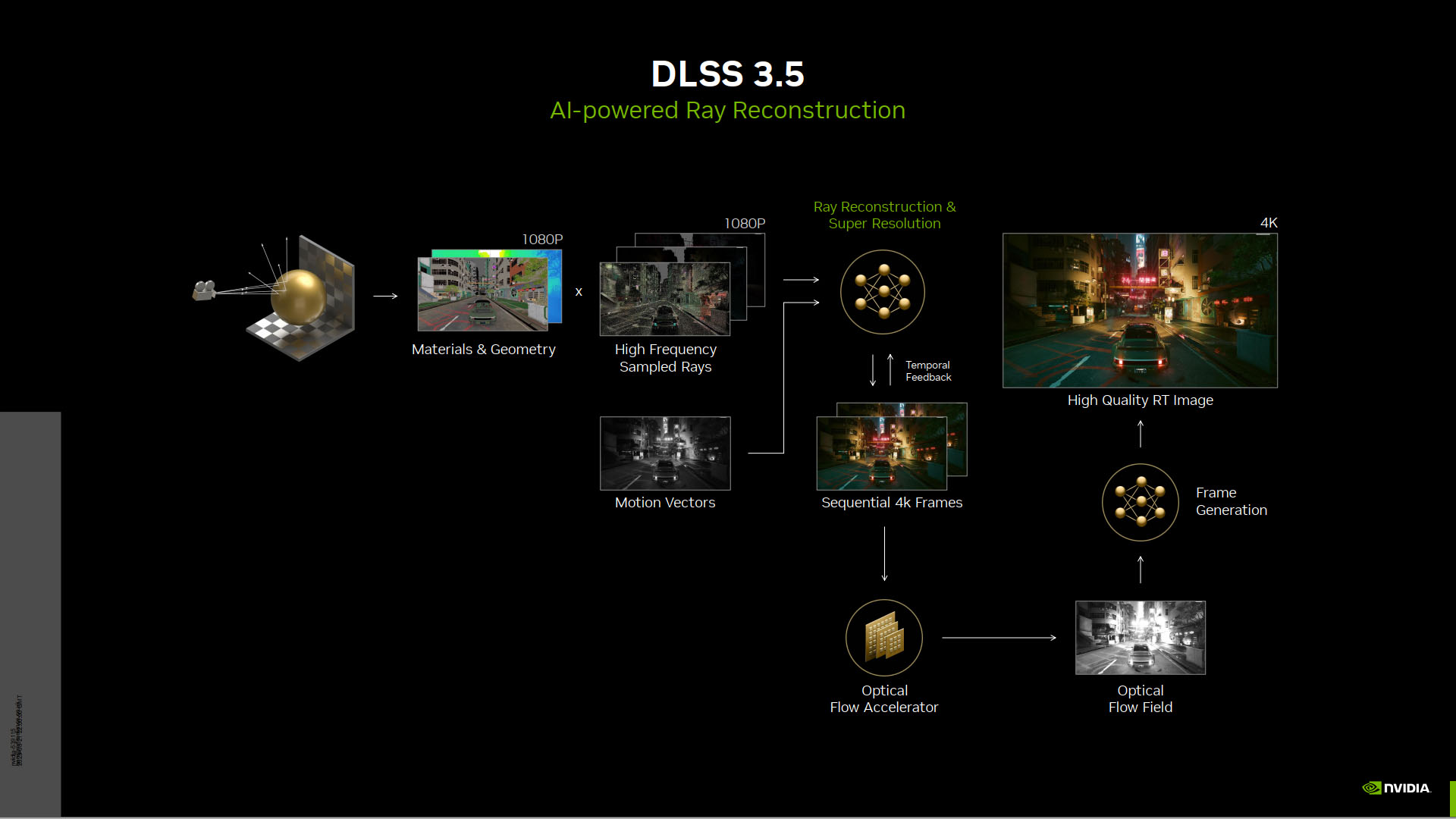
The extra image-producing power of DLSS 3.5 is highlighted in the image below which shows a scene only rendered with ray tracing. There’s no non-ray-traced traditional render filling in the detail, but rather DLSS 3.5 fills in the gaps from previous ray-traced samples. On the left is the low-detail result of using just one isolated ray tracing snapshot (i.e. DLSS off), while on the left is the result of multiple ray-traced samples being brought together with DLSS 3.5. The image is generated using the real-time ray tracing renderer D5 Render.
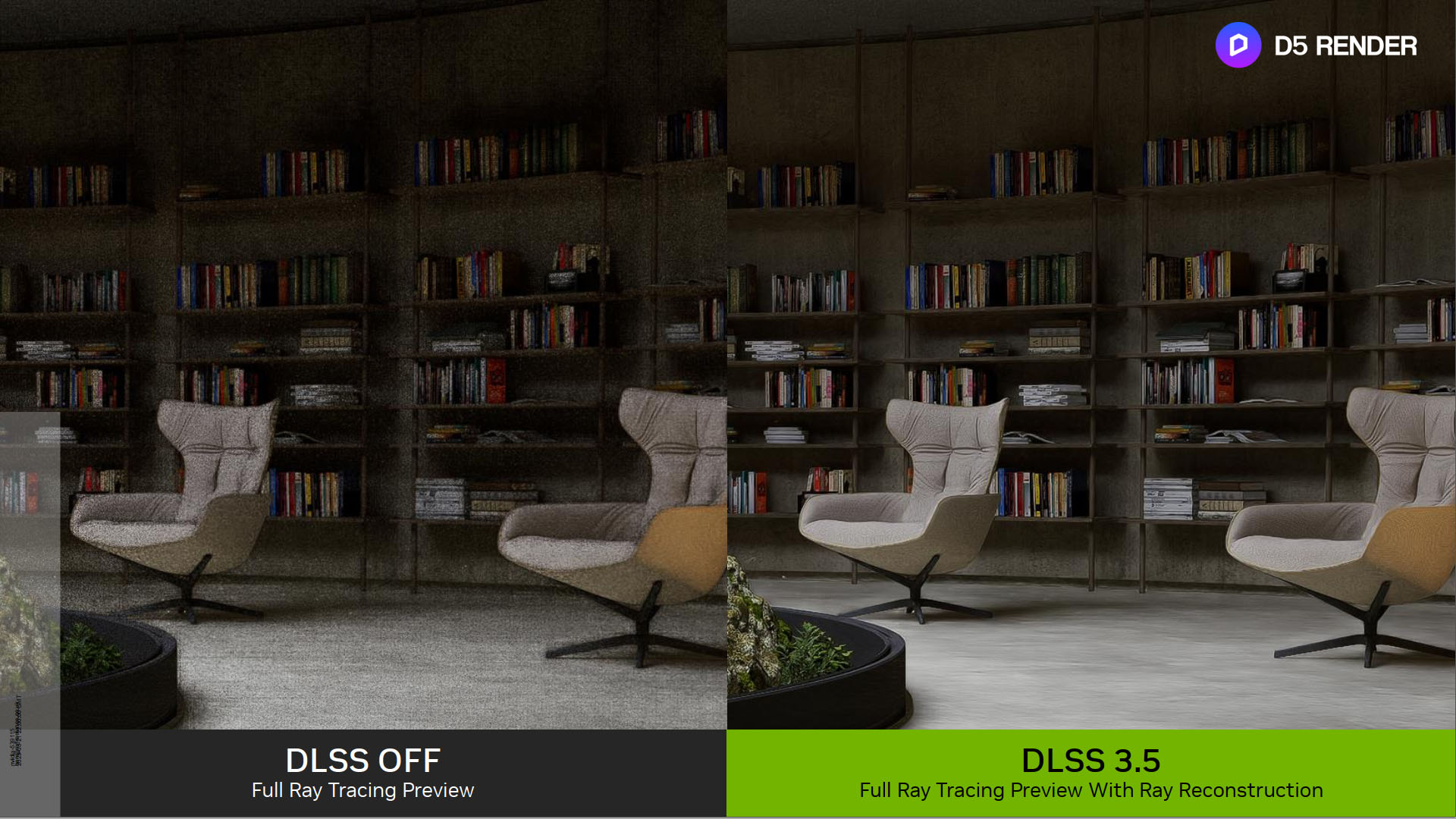
Which games support DLSS 3.5?
- Alan Wake 2 Launches October 27, 2023 With DLSS 3.5, full ray tracing and Reflex
- Cyberpunk 2077 & Cyberpunk 2077: Phantom Liberty will be available in September, 2023, with DLSS 3.5, full ray tracing and Reflex
- Portal with RTX upgrades to DLSS 3.5 in fall, 2023
- DLSS 3.5 is also coming to GeForce NOW when Alan Wake 2, Cyberpunk 2077: Phantom Liberty launch day-and-date in the cloud. Members can also stream the DLSS 3.5 update for Portal with RTX from the cloud.
Can my graphics card run DLSS 3.5?
DLSS 3.5 ray reconstruction will run on all Nvidia GeForce RTX graphics cards, rather than being restricted to RTX 4000 series cards, such as the GeForce RTX 4070, as with Nvidia’s DLSS 3 AI frame generation tech.
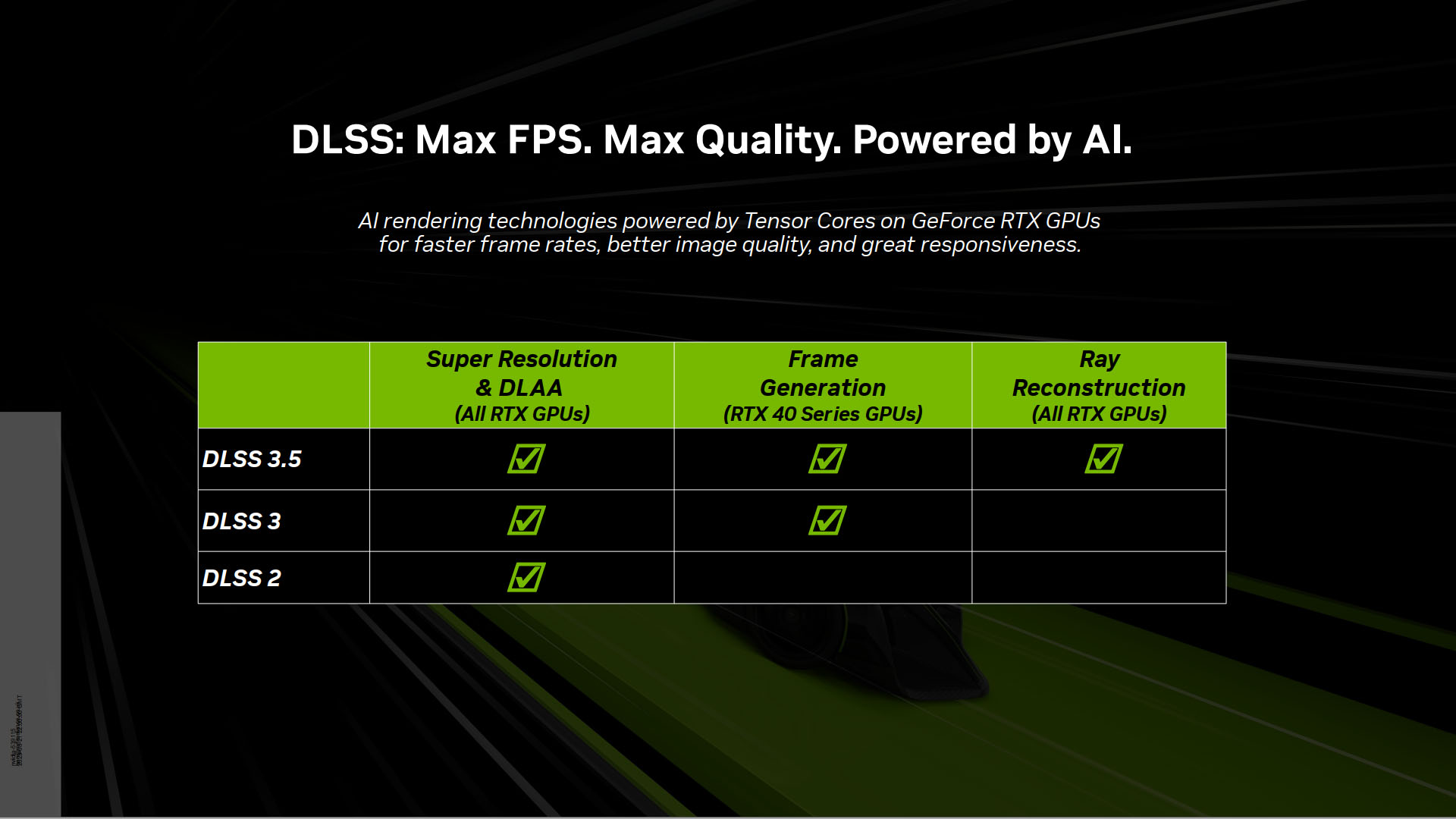
Yes, it’s confusing. We reached out to Nvidia for confirmation of why it has chosen to use this naming convention, rather than just call each technology something different. Nvidia’s senior PR manager for northern Europe, Jen Anderson, replied, ‘DLSS 3.5 is a suite of AI rendering technologies powered by Tensor Cores on GeForce RTX GPUs… The reason Frame Generation is only available on RTX 40-series GPUs is because it requires the use of Optical Flow Accelerator (only available on GeForce RTX 40 Series) to create additional high-quality frames.’
That’s still some fairly fuzzy reasoning if you ask us, but the bottom line is that owners of RTX 2000 series, such as the RTX 2060, and RTX 3000 cards, such as the RTX 3060, will be able to use the very latest DLSS 3.5 ray reconstruction tech but won’t have access to the ‘older’ DLSS 3 frame generation tech, which was introduced with the Nvidia Ada architecture.
Half-Life 2 RTX
Amongst a handful of other announcements from Nvidia at Gamescom, perhaps the biggest other piece of news is that Half-Life 2 will be getting the RTX treatment, via the RTX Remix community. Just as with Portal RTX and Quake 2 RTX, it will be getting full ray-traced lighting added to it, bringing a new visual flare to the nearly 20-year-old classic FPS. Development has only just begun but if you have some coding skills the project is looking for modders to help out.
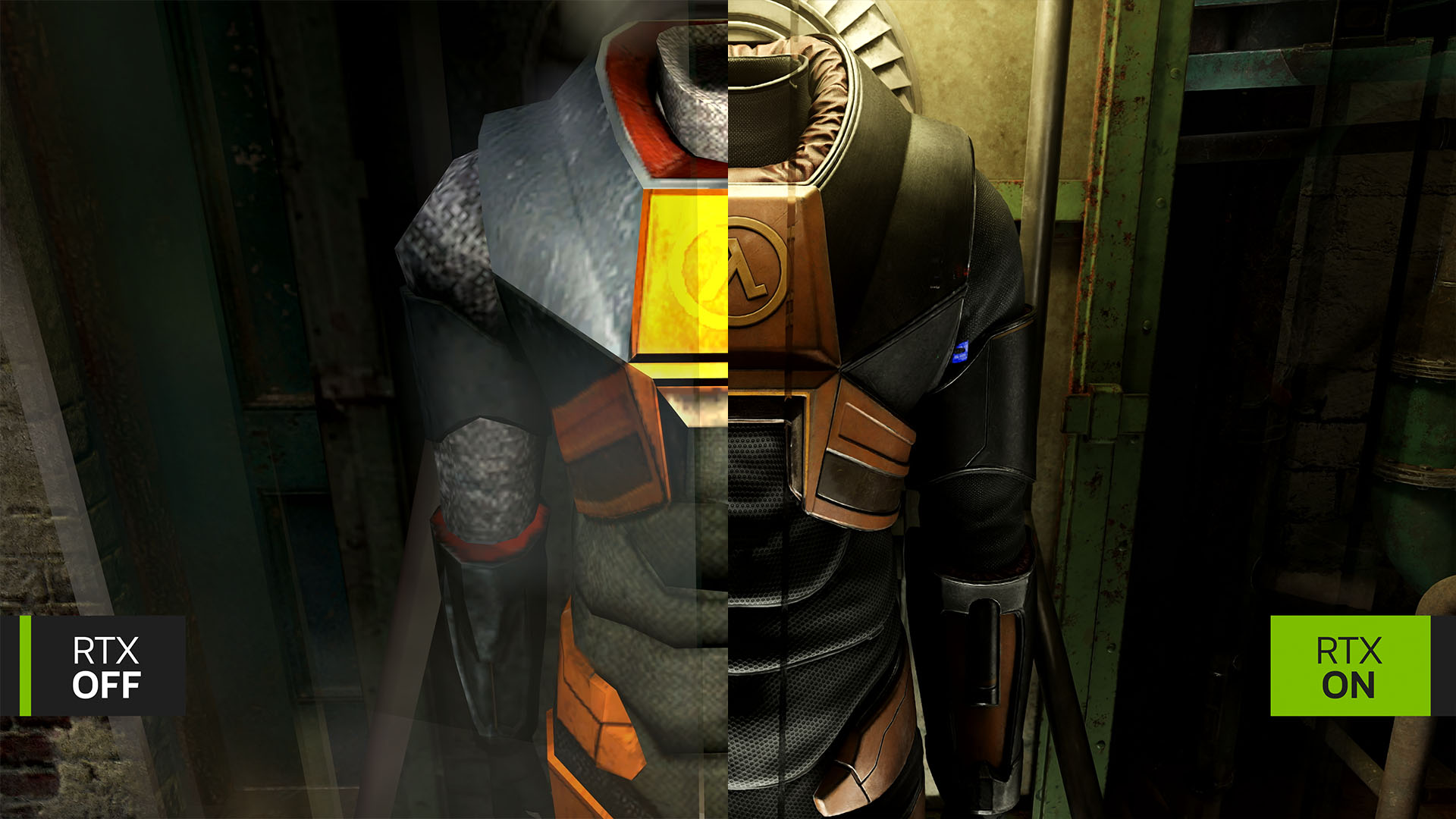
Also announced are that Call of Duty: Modern Warfare 3, PayDay 3, and Fortnite will be getting DLSS 3 support, with all but Fortnite also getting Nvidia Reflex – Fortnite already has the response time-reducing tech.
It’s Nvidia’s continued excellence with its DLSS technology that is a large part of the reason why its GPUs retain so many top spots on our best graphics card list. And while the ray-tracing-specific nature of DLSS 3.5 means it’s of more niche appeal than previous DLSS technologies, it’s still great to see Nvidia continuing to innovate. Even if it does insist on locking down its technologies.
Are you excited for DLSS 3.5 ray reconstruction? Is Half-Life 2 RTX the bigger news story for you, or is ray tracing still not something of interest? Let us know your thoughts on the Custom PC Facebook page, via Twitter, or join our Custom PC and Gaming Setup Facebook group and tap into the knowledge of our 400,000+ members.
